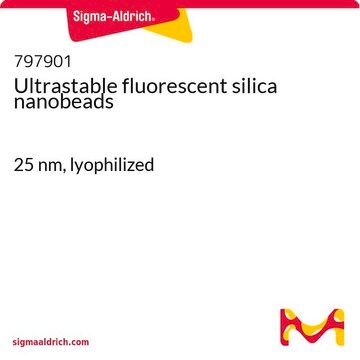Products may be shipped at a different temperature than the recommended long-term storage temperature. If the product quality is sensitive to short-term exposure to conditions other than the recommended long-term storage, it will be shipped on wet or dry-ice. If the product quality is NOT affected by short-term exposure to conditions other than the recommended long-term storage, it will be shipped at ambient temperature. As shipping routes are configured for minimum transit times, shipping at ambient temperature helps control shipping costs for our customers. For more information, please refer to the Storage and Transport Conditions document: https://www.sigmaaldrich.com/deepweb/assets/sigmaaldrich/marketing/global/documents/316/622/storage-transport-conditions-mk.pdf
Wichtige Dokumente
637246
Siliciumdioxid
nanopowder (spherical, porous), 5-20 nm particle size (TEM), 99.5% trace metals basis
Synonym(e):
Silicium(IV)-oxid, Siliziumdioxid
Größe auswählen
Größe auswählen
About This Item
Empfohlene Produkte
Qualitätsniveau
Assay
99.5% trace metals basis
Form
nanopowder (spherical, porous)
Oberflächenbereich
590-690 m2/g , TEM
Partikelgröße
5-20 nm (TEM)
bp
2230 °C (lit.)
mp (Schmelzpunkt)
>1600 °C (lit.)
Dichte
2.2-2.6 g/mL at 25 °C
Schüttdichte
0.068 g/mL
SMILES String
O=[Si]=O
InChI
1S/O2Si/c1-3-2
InChIKey
VYPSYNLAJGMNEJ-UHFFFAOYSA-N
Suchen Sie nach ähnlichen Produkten? Aufrufen Leitfaden zum Produktvergleich
Verwandte Kategorien
Allgemeine Beschreibung
Anwendung
- Pickering emulsion polymerization using a silicon dioxide nanoparticle stabilizer to form molecularly imprinted polymers for steroid recognition.[1]
- Mesoporous silica is used as a catalyst support in the preparation of multiwalled carbon nanotubes (MWCNTs).[2]
- It is used as a ring opening of tetrahydrofuran-dimethanol to 1,2,6-hexanetriol.[3]
- It maybe used to prepare silica/brominated poly(phenylene oxide) nanocomposites membranes for CO2 seperations.[4]
- The composite scaffold of chitosan/chondroitin sulfate/nano-SiO2 was fabricated by lyophilization.[5]
- Nanocomposites preparation of silica, single-wall carbon nanotubes, and graphite nanoplatelets in an epoxy matrix have been reported.6
- Dielectric spectroscopy study of the polystyrene/nanosilica model system has been studied.[6]
- PMMA SiO2 nanocomposites were reported to be synthesized.
Lagerklassenschlüssel
11 - Combustible Solids
WGK
nwg
Flammpunkt (°F)
Not applicable
Flammpunkt (°C)
Not applicable
Persönliche Schutzausrüstung
dust mask type N95 (US), Eyeshields, Gloves
Hier finden Sie alle aktuellen Versionen:
Besitzen Sie dieses Produkt bereits?
In der Dokumentenbibliothek finden Sie die Dokumentation zu den Produkten, die Sie kürzlich erworben haben.
Kunden haben sich ebenfalls angesehen
Artikel
Review the potential of self-assembled multilayer gate dielectric films fabricated from silane precursors for organic, inorganic, and transparent TFT and for TFT circuitry and OLED displays.
Hydrogen is one of the most important resources in providing food, fuel, and chemical products for our everyday life. Sustainable catalytic hydrogen production from bioethanol has gained significant attention in recent years due to globally diminishing fossil fuel supplies, which have necessitated the search for new chemical feedstocks.
Recent demand for electric and hybrid vehicles, coupled with a reduction in prices, has caused lithium-ion batteries (LIBs) to become an increasingly popular form of rechargeable battery technology.
Silica's versatility spans various industries, including biomedical applications.
-
How is shipping temperature determined? And how is it related to the product storage temperature?
1 answer-
Helpful?
-
-
How can I determine the shelf life / expiration / retest date of this product?
1 answer-
If this product has an expiration or retest date, it will be shown on the Certificate of Analysis (COA, CofA). If there is no retest or expiration date listed on the product's COA, we do not have suitable stability data to determine a shelf life. For these products, the only date on the COA will be the release date; a retest, expiration, or use-by-date will not be displayed.
For all products, we recommend handling per defined conditions as printed in our product literature and website product descriptions. We recommend that products should be routinely inspected by customers to ensure they perform as expected.
For products without retest or expiration dates, our standard warranty of 1 year from the date of shipment is applicable.
For more information, please refer to the Product Dating Information document: https://www.sigmaaldrich.com/deepweb/assets/sigmaaldrich/marketing/global/documents/449/386/product-dating-information-mk.pdfHelpful?
-
Active Filters
Unser Team von Wissenschaftlern verfügt über Erfahrung in allen Forschungsbereichen einschließlich Life Science, Materialwissenschaften, chemischer Synthese, Chromatographie, Analytik und vielen mehr..
Setzen Sie sich mit dem technischen Dienst in Verbindung.





